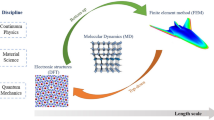Abstract
In the present study, a body-fitted and uniform initial particle arrangement method is proposed for mesh-free methods, such as SPH, MPS, and LSMPS. Single-layer boundary particles with/without normal direction vectors and multilayer boundary particles can be successfully generated. Typical tests show that the proposed method can successfully generate body-fitted and uniform initial particle distributions. Numerical simulation results using the generated initial particle distributions obtained satisfied results. It is then verified that the present method can be usefully and robustly for mesh-free particle simulations.















Similar content being viewed by others
References
Gingold RA, Monaghan JJ (1977) Smoothed particle hydrodynamics: theory and application to non-spherical stars. Mon Not R Astron Soc 181:375–389
Lucy LB (1977) A numerical approach to testing the fission hypothesis. Astron J 82:1013–1024
Koshizuka S, Oka Y (1996) Moving-particle semi-implicit method for fragmentation of incompressible fluid. Nucl Sci Eng 123:421–434
Morita K, Zhang S, Koshizuka S et al (2011) Detailed analysis of key phenomena in core disruptive accidents of sodium-cooled fast reactors by the COMPASS code. Nucl Eng Des 241:4672–4681
Monaghan JJ (1994) Simulating free surface flows with SPH. J Comput Phys 110:399–406
Benz W, Asphaug E (1995) Simulations of brittle solids using smooth particle hydrodynamics. Comput Phys Commun 87:253–265
Zhang C, Rezavand M, Hu X (2021) A multi-resolution SPH method for fluid-structure interactions. J Comput Phys 429:110028
Siemann MH, Ritt SA (2019) Novel particle distributions for SPH bird-strike simulations. Comput Methods Appl Mech Eng 343:746–766
Alimirzazadeh S, Kumashiro T, Leguizamón S et al (2020) GPU-accelerated numerical analysis of jet interference in a six-jet Pelton turbine using finite volume particle method. Renew Energy 148:234–246
Ji Z, Stanic M, Hartono EA et al (2018) Numerical simulations of oil flow inside a gearbox by smoothed particle hydrodynamics (SPH) method. Tribol Int 127:47–58
Crespo AJC, Hall M, Domínguez JM, et al. (2018) Floating moored oscillating water column with meshless SPH method. In: ASME 2018 37th international conference on ocean, offshore and Arctic engineering, Madrid
Zhang C, Wang J, Rezavand M et al (2021) An integrative smoothed particle hydrodynamics framework for modeling cardiac function. Comput Methods Appl Mech Eng 381:113847
Domínguez JM, Crespo AJC, Barreiro A, et al. (2011) Development of a new pre-processing tool for SPH models with complex geometries. In: 6th international SPHERIC workshop, Hamburg
Heimbs S (2011) Computational methods for bird strike simulations: a review. Comput Struct 89:2093–2112
Diehl S, Rockefeller G, Fryer CL et al (2015) Generating optimal initial conditions for smoothed particle hydrodynamics simulations. Publ Astron Soc Austral 32:e048
Vela LV, Sanchez R, Geiger J (2018) ALARIC: an algorithm for constructing arbitrarily complex initial density distributions with low particle noise for SPH/SPMHD applications. Comput Phys Commun 224:186–197
Fu L, Ji Z (2019) An optimal particle setup method with centroidal Voronoi particle dynamics. Comput Phys Commun 234:72–92
Zhu Y, Zhang C, Yu Y, Hu X (2021) A CAD-compatible body-fitted particle generator for arbitrarily complex geometry and its application to wave-structure interaction. J Hydrodyn 33:195–206
Osher S, Sethian JA (1988) Fronts propagating with curvature-dependent speed: algorithms based on Hamilton–Jacobi formulations. J Comput Phys 79:12–49
Shu R, Liu A (1991) A fast ray casting algorithm using adaptive isotriangular subdivision. In: Proceedings of the 2nd conference on visualization, Washington
Tamai T, Koshizuka S (2014) Least squares moving particle semi-implicit method. Comput Part Mech 1:277–305
Lobovský L, BotiaVera E, Castellana F, MasSoler J, SoutoIglesias A (2014) Experimental investigation of dynamic pressure loads during dam break. J Fluids Struct 48:407–434
Author information
Authors and Affiliations
Corresponding author
Ethics declarations
Conflicts of interest
The authors declare no conflicts of interest.
Additional information
Publisher's Note
Springer Nature remains neutral with regard to jurisdictional claims in published maps and institutional affiliations.
Rights and permissions
Springer Nature or its licensor holds exclusive rights to this article under a publishing agreement with the author(s) or other rightsholder(s); author self-archiving of the accepted manuscript version of this article is solely governed by the terms of such publishing agreement and applicable law.
About this article
Cite this article
Zhang, S., Kong, Y., Cheng, Q. et al. Initial particle arrangement for the arbitrarily complex geometry of mesh-free methods. Comp. Part. Mech. 10, 663–675 (2023). https://doi.org/10.1007/s40571-022-00519-0
Received:
Revised:
Accepted:
Published:
Issue Date:
DOI: https://doi.org/10.1007/s40571-022-00519-0




